
The steam locomotives of British Railways were used by British Railways over the period 1948–1968. The vast majority of these were inherited from its four constituent companies, the "Big Four".

The first Locomotives of the Great Western Railway (GWR) were specified by Isambard Kingdom Brunel but Daniel Gooch was soon appointed as the railway's Locomotive Superintendent. He designed several different 7 ft 1⁄4 in broad gauge types for the growing railway, such as the Firefly and later Iron Duke Class 2-2-2s. In 1864 Gooch was succeeded by Joseph Armstrong who brought his standard gauge experience to the workshops at Swindon. To replace some of the earlier locomotives, he put broad gauge wheels on his standard gauge locomotives and from this time on all locomotives were given numbers, including the broad gauge ones that had previously carried just names.
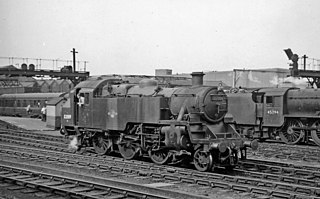
The BR Standard Class 3 2-6-2T was a class of steam locomotive designed by Robert Riddles for British Railways. It was essentially a hybrid design, the chassis being closely based on and sharing a number of parts with the LMS Ivatt Class 4, and having a boiler derived from a GWR No.2 boiler as fitted to the GWR Large Prairie 2-6-2T and 5600 Class 0-6-2T tank engines.

The Great Western Railway (GWR) 4200 Class is a class of 2-8-0T steam locomotives.
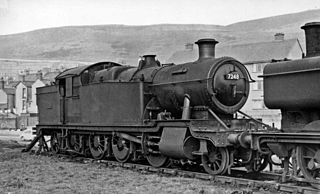
The Great Western Railway (GWR) 7200 Class is a class of 2-8-2T steam locomotive. They were the only 2-8-2Ts built and used by a British railway, and the largest tank engines to run on the Great Western Railway.

The GWR 5600 Class is a class of 0-6-2T steam locomotive built between 1924 and 1928. They were designed by Charles Collett for the Great Western Railway (GWR), and were introduced into traffic in 1924. After the 1923 grouping, Swindon inherited a large and variable collection of locomotives from historic Welsh railway companies, which did not fit into their standardisation programme. GWR boiler inspectors arrived en masse and either condemned the original locomotives or had them rebuilt. The systematic destruction of many examples of locomotives, most still in serviceable condition, followed, but various were worked alongside 5600 Class.
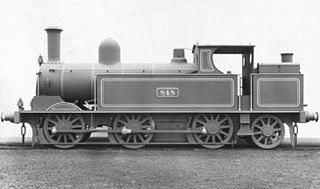
The London and North Western Railway (LNWR) Webb Coal Tank is a class of 0-6-2T steam locomotive. They were called "Coal Tanks" because they were a side tank version of Webb's standard LNWR 17in Coal Engine, an 0-6-0 tender engine for slow freight trains.
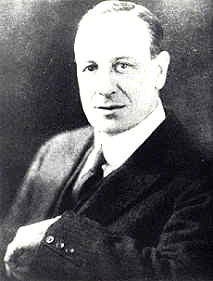
Charles Benjamin Collett was Chief Mechanical Engineer of the Great Western Railway from 1922 to 1941. He designed the GWR's 4-6-0 Castle and King Class express passenger locomotives.

The LNWR 1185 Class was a class of 0-8-2T steam tank locomotives designed by Charles Bowen-Cooke and introduced in 1911. They passed into LMS ownership in 1923 and 8 survived to British Railways ownership in 1948. British Railways numbers were 47875-47896.

The Rhymney Railway M class was a class of 0-6-2T tank locomotive introduced into traffic on the Rhymney Railway in 1904. These were substantial sized tank engines, and weighed 66 long tons and were 36 feet 9 inches (11.20 m) in length.
The Rhymney R class was a class of 0-6-2T steam locomotive introduced into traffic in 1907 designed by the railway's engineer Hurry Riches. These were substantial sized tank locomotives, and weighed 67 long tons and were 37 feet (11.28 m) in length.
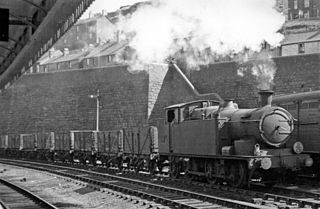
The Rhymney Railway A class were 0-6-2T tank locomotives introduced into traffic in 1910 and designed by the railway's engineer Hurry Riches. These were substantial sized tank engines, and weighed 64 long tons and were 35 ft 9 in (10.90 m) in length.
The Rhymney Railway P class was a class of 0-6-2T steam locomotive introduced into traffic in 1909 designed by the Rhymney Railway's engineer C. T. Hurry Riches. These were substantial sized tank locomotives, weighed 60 long tons and were 35 feet 0 inches (10.67 m) in length.

Brecon and Merthyr 0-6-2T locomotives were steam tank locomotives of the Brecon and Merthyr Railway including classes 36 and 45.
The Neath and Brecon Stephensons were 0-6-2T tank locomotives introduced into traffic on the Neath and Brecon Railway in 1904 from a Rhymney Railway design. There were three locos in the class. They were built by Robert Stephenson and Company and were almost identical to the successful Rhymney Railway M class.
The Port Talbot Railway Stephenson Class were eleven 0-6-2T locomotives introduced into traffic in 1898 designed and built by Robert Stephenson and Company. They predated the somewhat similar but larger Rhymney Railway M class by six years.
The Barry Railway Class H was a small class of seven 0-8-2T tank locomotives built for the Barry Railway by Sharp Stewart in 1896. When they were introduced they were the first locomotives in Britain to use the 0-8-2 wheel arrangement.
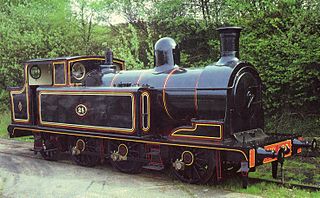
The Taff Vale Railway (TVR) O1 class is a class consisting of fourteen 0-6-2T steam tank locomotives, designed by Tom Hurry Riches, which were introduced to the TVR during the period 1894-1897.
Barry Railway Class D were 0-8-0 steam tender engines of the Barry Railway in South Wales. They were built to a standard Sharp, Stewart and Company design modified by John Waddington Mann, the Chief Mechanical Engineer for the Swedish & Norwegian Railway. In fact, 20 of these locomotives were ordered by this railway. However the company ran into severe financial difficulty with the result that only one and a half locomotives were paid for by the S&N.

The GWR Rheidol Tanks are a fleet of 2-6-2T steam locomotives of the Great Western Railway design built between 1923 and 1924. They were designed by the railway's Chief Mechanical Engineer, Charles Collett, for working services on the Vale of Rheidol Railway between Aberystwyth and Devil's Bridge.
















